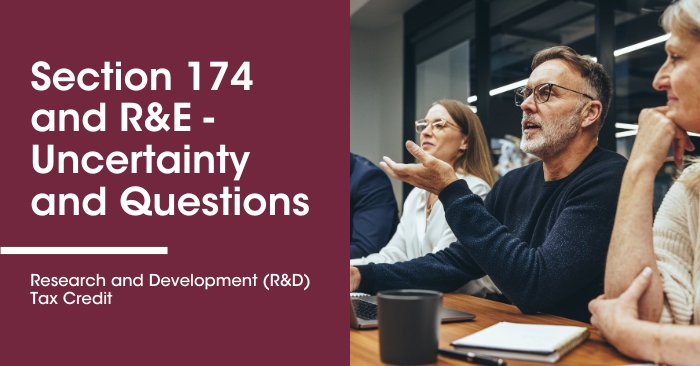Section 174 and R&E – Uncertainty and Questions
by Kevin Zolriasatain | Principal, KBKG, 3/23/2023
Many businesses, small and large, rely on research and development to improve their offerings, compete with international markets, and increase profits. The implications of recent changes to section 174 and no movement from Congress have left many business owners unsure of how to move forward with R&E expenses for the 2022 tax year and beyond. Learn more about the uncertainties regarding Section 174 and how companies might be impacted.
What Changed with Section 174?
Section 174 was originally enacted in 1954 and allowed businesses to deduct 100% of expenses for research and development in the year they were incurred. The aim of this legislation was to incentivize businesses to pursue R&E opportunities that improve performance, product development, and other business processes.
However, the Tax Cuts and Jobs Act of 2017 made changes to Section 174, which went into effect for tax years beginning after December 31, 2021. Under the TCJA, businesses are now required to capitalize and amortize R&D costs over a five-year period for domestic costs and a 15-year period for foreign costs. Additionally, software development expenses are now included under the umbrella of Section 174 and are required to be capitalized and amortized.
Why Is There Bi-Partisan Support to Restore R&E Expensing?
There has been overwhelming bi-partisan support to repeal the required R&E amortization or to delay its implementation. The 2017 changes to Section 174 have a tremendous negative impact on taxpayers, significantly raising their taxable income and raising concerns for many. The impact would be largest on startups and small businesses that rely on this tax benefit for developing new products, expanding their facilities, hiring new employees or contractors, or experimenting with new technology and software.
Additionally, these issues would have a larger impact on the U.S. economy and competitiveness on a world scale. The U.S. is one of two developed countries requiring amortization of R&E expenses, disadvantaging American companies and discouraging businesses from pursuing innovation and experimentation in a wide range of industries.
The American Innovation and Jobs Act
Senator Hassan introduced the American Innovation and Jobs Acts, a bill that includes over 30 bi-partisan cosponsors. The purpose of this proposed bill is to immediately allow full expensing of R&E expenditures and would be applied retroactively for tax years beginning after December 31, 2021.
What Uncertainties Remain Concerning Section 174?
While taxpayers had hoped for a decision on section 174 by the end of 2022, Congress has not approved any changes to the newly enacted amendments. Business owners are unsure about how to proceed with their 2022 R&E deduction strategy.
Should they hope for the best? Or should they expect the worst and cut back on spending and explore loans and other options for making these additional payments? Many businesses requested extensions in hopes of Congress retroactively restoring R&E expenses in full.
What Does the IRS Recommend?
The IRS has provided little guidance on how taxpayers can adhere to the new requirements, and many tax professionals feel as if their hands are tied. Without a Congress amendment, there is little business owners or tax professionals can do to circumvent the consequences of these changes.
The IRS released Revenue Procedure 2023-11. This document was an amendment of the Rev. Proc. 2023-8. It waives the requirement for businesses to fill out Form 3115 for the first tax year.
What Is the Interaction Between Section 174 and the R&D Tax Credit Under Section 41?
The IRS section 41 research credit is a permanent tax incentive for qualified research activities, which can be determined using the four-part test for R&D qualification:
- Permitted Process: The research activity must be directly tied to developing a new or improved business component for a permitted purpose (functionality, quality, performance and/or reliability). Notably, the business does not have to be successful in improving the component to earn the credit.
- Technological in Nature: The activities performed must fundamentally rely on hard sciences. For example, the activities should be grounded in biology, computer science, physics, engineering, chemistry, geology, or a similar field.
- Eliminate Uncertainty: At the outset, the taxpayer should have uncertainty around either the appropriate design, method, or capability to achieve the intended results. For example, the taxpayer could not know whether a product is feasible, if the design is technically sound, or how the result can be achieved.
- Process of Experimentation: Businesses must experiment and evaluate alternatives through a process of modeling, testing, simulating, and systematic trial and error.
While both IRS section 174 and section 41 deal with incentives to encourage research and development, section 174 covers a wider range of expenses. However, the costs claimed under section 41 must also meet section 174 requirements. Additionally, section 41 qualified research does not include activities that involve:
- Surveys, advertising, or market research
- Duplication or adaptation of an existing business component
- Research conducted outside of the U.S.
- Research in the arts, humanities, or soft sciences
- Funded research from a grant, government, or other outside entities
The changes listed in TJCA did not have a material impact on the section 41 credit. However, the proposed American Innovation and Jobs Act would expand this section as it pertains to qualified small businesses. As noted in section 41(h), qualified small businesses can currently utilize the R&D credit to offset payroll tax. Some of the suggested amendments include doubling the cap from $250,000 to $500,000, allowing startups to claim the refundable credit for up to eight years instead of five, expanding the startup credit rate to 20%, and increasing the gross receipts threshold to $15M.
Develop a Strategy for R&E Expenses
While there is still hope Congress will come to an agreement and repeal the R&E amortization, the future is uncertain. Businesses must work with tax professionals to comply with current tax laws and ensure accurate tax filings, which includes having a strategy for tracking 174 expenses.
KBKG can assist taxpayers in understanding their options for funding R&E activities and consult on navigating the road ahead concerning section 174. We understand this time is stressful for many, and we are here to help. Contact us today to learn if your business could qualify for the R&E tax credit and to get your questions answered. Ask us about our R&D credit studies for R&D projects across a range of industries from software development processes to bio-tech research.
Related Articles
- IRC/Multistate Corporate Income Tax Comparison Guide
- AICPA Pens Letter Urging Congress to Defer R&D Expense Capitalization (Sec 174) Provision Until 2026
- IRS Issued Additional Guidance on Section 174, Specified Research or Experimental Expenditures
- KBKG Tax Insight: Tax Court Denies Construction Company R&D Credits
- Mississippi Allows Businesses to Deduct Research or Experimental Expenditures
- American Innovation and Jobs Act Aims to Expand R&D Tax Credits and Address Confusion Over Section 174 Rules
About the Author
 Kevin Zolriasatain – Principal
Kevin Zolriasatain – Principal
Pasadena
Kevin is a Principal and Practice Leader of KBKG’s Research and Development (R&D) Tax Credit Services from our Pasadena headquarters. He has over 20 years of consulting experience providing R&D tax credit services to companies of various sizes. Prior to KBKG, he spent nearly a decade at PricewaterhouseCoopers, focusing on securing R&D Tax Credits for Fortune 500 companies. Kevin enjoys working with small to mid-size business owners and over his career has documented hundreds of millions of dollars in research credits. » Full Bio


